Kate Winslet, Jodie Foster Carnage
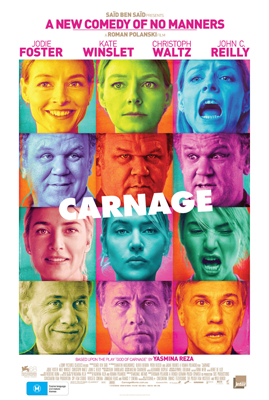
Carnage
Cast: Kate Winslet, Christoph Waltz, John C. Reilly, Jodie FosterDirector: Roman Polanski
Genre: Drama, Comedy
Rated: M
Running Time: 79 minutes
Synopsis: Carnage is a razor sharp, biting comedy centered on parental differences. After two boys duke it out on a playground, the parents of the "victim" invite the parents of the "bully" over to work out their issues. A polite discussion of childrearing soon escalates into verbal warfare, with all four parents revealing their true colors. None of them will escape the carnage.
Release Date: March 1st, 2012
Production Story
Carnage stars Academy Award®-winner Kate Winslet (Mildred Pierce, The Reader) and Academy Award®-winner Christoph Waltz (Water for Elephants, Inglourious Basterds) as husband and wife Nancy and Alan Cowan, opposite Academy Award®-winner Jodie Foster (Panic Room, The Silence of the Lambs) and Academy Award®-nominee John C. Reilly (We Need to Talk About Kevin, Chicago, Magnolia) as Penelope and Michael Longstreet, respectively.
Yasmina Reza joined Roman Polanski in adapting her play God of Carnage for the screen. Said Ben Said (The Witnesses, Love Crime) produced the film through SBS Productions. Carnage is a French- German-Polish co-production between SBS Productions, Constantin Film Produktion and SPI Poland. Other production credits include: Pawel Edelman (The Ghost Writer, The Pianist) as director of photography; Academy Award®-winner Dean Tavoularis (The Godfather, Apocalypse Now) as production designer; costume designer Milena Canonero, Academy Award®-winner for Marie Antoinette, Barry Lyndon and Chariots of Fire; Academy Award®-winner Didier Lavergne (La Vie en Rose, The Ghost Writer,) as make-up designer and Hervé de Luze (The Ghost Writer, The Pianist) as editor.
Academy Award®-winning director Roman Polanski directs Kate Winslet, Jodie Foster, John C. Reilly and Christoph Waltz in Carnage, the screen adaptation of the smash comedy play "God of Carnage" by Yasmina Reza.
The bitterly amusing story of two families who become locked in a showdown after their children are involved in a playground squabble, Carnage shines a spotlight on the risible contradictions and grotesque prejudices of four well-heeled American parents.
Shot in real time as the four adults meet to settle the dispute, Carnage pits power couple Nancy and Alan Cowan against the liberal writer and campaigner Penelope Longstreet and her wholesaler husband, Michael. Unpredictable and shocking, the film hilariously exposes the hypocrisy lurking behind their polite façade.
Hailed by the critics and public alike, the play enjoyed sell-out runs in Paris, London and on Broadway after its premiere in 2006 and won a slew of awards at both the Olivier Awards and the Tony® Awards, including Best Play and Best Direction of a Play.
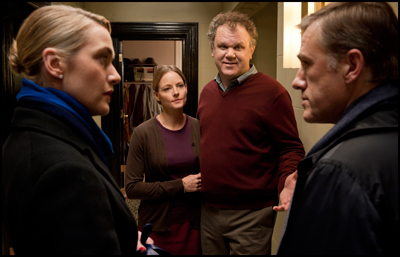 As soon as he saw the play, Roman Polanski knew it would make an exciting film. "The tone of the play was hilarious and the pace fast-moving. What particularly attracted me was the real-time action. I'd never made a film without the slightest ellipse and I don't remember ever seeing one either."
As soon as he saw the play, Roman Polanski knew it would make an exciting film. "The tone of the play was hilarious and the pace fast-moving. What particularly attracted me was the real-time action. I'd never made a film without the slightest ellipse and I don't remember ever seeing one either." Roman Polanski brought on the author of the play, Yasmina Reza, to adapt it for the screen. Originally set in Paris, the play's location was moved to New York when it was transferred to Broadway in 2009. It is in Brooklyn that Polanski chose to set his film adaptation.
"The spirit of the play seemed to me more American than French and Brooklyn would be a likely place for this kind of liberal family to live."
The director also wanted to remain faithful to the play's real-time setting where the action unfolds over 90 minutes without breaks and in one location - despite the challenges that would mean. "It's a challenge to make a film in real time," says Roman Polanski. "Ever since I was a child I enjoyed films that evolved in a single location far more than action films. I like the sensation of the proximity to the characters, similar to the feeling to be found in Dutch paintings such as Van Eyck's The Arnolfini Wedding, where the artist gives the spectator the sensation of being in the room. I've made films before set in an enclosed space, but not as rigorously self-contained as on this occasion, so that was a new experience."
The Cast
Roman Polanski then assembled his cast - Academy Award®-winner Kate Winslet (Mildred Pierce, The Reader) and Academy Award®-winner Christoph Waltz (Water for Elephants, Inglourious Basterds) as Nancy and Alan Cowan, opposite Academy Award�-winner Jodie Foster (Panic Room, The Silence of the Lambs) and Academy Award®-nominee John C. Reilly (We Need to Talk About Kevin, Chicago, Magnolia) as Penelope and Michael Longstreet.
All of the actors were required to be on set all day, every day, throughout the shoot, as they all feature in every scene. "To film in that way you must have actors who can live with each other," says Roman Polanski. "The four characters they were playing were of such different traits and types. It was a stroke of luck that these four actors could function so well together, in complete harmony. It just doesn't happen on every production!"
Kate Winslet describes investment broker Nancy Cowan as "an extremely busy working mother, who constantly feels desperately guilty about not being present enough in her child's life and yet has very forthright opinions about motherhood and parenting when in fact she's clutching at straws. Although she loves her child, there are certain areas where she doesn't really know what she's talking about."
For Kate Winslet the play's success resides in how its universal themes are couched in humour. "It's a window on so many of our worlds," she says. "It's about the complexities of parenting, it's about how children should be raised, and it's about the endlessly complex dynamic that is marriage. And to have turned it into a comedy in the way that Yasmina did is even more enriching and enlightening for everybody. To be able to laugh at ourselves, to be able to make fun of the human condition, is the thing that no matter what language you speak or which country you're in or what your personal circumstances are we've all experienced in some way."
"It's very real," continues Kate Winslet. "For example, in the school playground when you're negotiating with other parents there's always an air of 'I have to be nice to you even though I hate your guts.'
There's always glossy air of making nice, a fakery that goes on which is part of how you operate as a parent when you're trying to protect your child."
The actress also responded to the piece's savage depiction of how our lives are dominated by technology. "It shows how easy it is to become disengaged from your own reality. It's as though we've gotta get that quick fix you know to plug the gaps in our relationships. We rely on checking our texts or sending a text back or waiting for that 'brruuupp'. We've all become so accustomed to this way of existing and validating our friendships through those non-verbal connections."
Kate Winslet was enthralled by the multi-layered nature of the piece. "What's fascinating about this is that it starts off being about one thing and it becomes very quickly entirely about something else," she says. "I love that about the story; it's very real but it's unpredictable. You think you're watching one type of movie and actually, it changes very quickly into something very different."
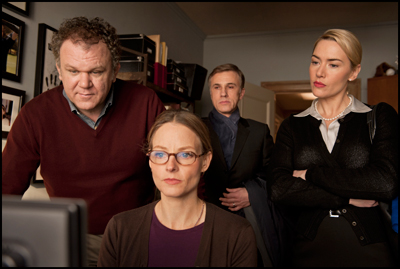 For Jodie Foster, who plays campaigner Penelope Longstreet, it was the ideas the story tackles that provided the strongest attraction. "Although it's satirical and outlandish in some respects, the relationship between the characters have a genuine grounding in real psychology, in family psychology, and it's the tapestry of people's lives that I find most fascinating - how they interact with each other, how they drive each other crazy, how they stab each other over and over again, not just in this generation but in the next generation, too. Our ideas about morality are constructs and in fact we're all very primitive. We're all monstrous in some ways and if we took responsibility for that we'd probably be better off."
For Jodie Foster, who plays campaigner Penelope Longstreet, it was the ideas the story tackles that provided the strongest attraction. "Although it's satirical and outlandish in some respects, the relationship between the characters have a genuine grounding in real psychology, in family psychology, and it's the tapestry of people's lives that I find most fascinating - how they interact with each other, how they drive each other crazy, how they stab each other over and over again, not just in this generation but in the next generation, too. Our ideas about morality are constructs and in fact we're all very primitive. We're all monstrous in some ways and if we took responsibility for that we'd probably be better off." "The question of morality is interesting," Jodie Foster continues. "Four people are trying to figure out what's the right thing to do and is the right thing the right thing? As time goes on, they start revealing just who they really are. They become more and more monstrous, and I guess that's what makes it funny. They are all polite people, they're all well educated and older and are from upper middle class families and live in a very polite suburb and you'd think that everything would go very well and instead it all goes very badly indeed."
"It's a comedy of manners and how people lose those manners," says Jodie Foster. "What really makes it work is that each character is so well drawn and how different they are. So Kate Winslet's character is so good at always trying to be the liaison between everybody and yet we know that's not what she's really thinking, so we watch her cover up by becoming more and more solicitous."
Jodie Foster says she felt Penelope was "a very good fit." "She's very politically correct and takes everything way too seriously," says the actress. "She starts out as normal, but as the story progresses she becomes more and more of a caricature of a regular person. The character's relationships have a lot of layers. The problems in our marriage get worked out during this negotiation. She's an uptight woman who works in a bookstore but who's writing a book on suffering in Africa and who can't get that out of her mind. She's appalled by these two people who come into her home who, she thinks, don't seem to care about the plight of the world. Her husband is a good guy and he thinks that my uptightness is little too much and the way he avoids that is by drinking his favorite scotch."
Jodie Foster relished the twists and turns in the relationships between the four characters. "For much of the time, it is Penelope and Alan who dislike each other because he's a very cocky lawyer who likes to tease me because he's irritated by how politically correct I am. But soon all four are trading sides and by the end of the film we all hate each other. The story underlines the fragility of relationships and how scarred we all are."
The language also drew in the actress and she was intrigued by how Reza has the characters reveal themselves through coded language. "Penelope tends to continually say "that's disgusting" or "that disgusts me." Disgust seems to be my number one thing. And Nancy keeps saying "naturally" and yet she's the least natural person. Michael is the kind of guy who keeps saying "why can't we all just get along," you know, and "why do we have to think about things, why do we have to think about things at all."
For Kate Winslet too, the opportunity to immerse herself in the piece's rich and textural language was an immediate draw. "We hear the characters use really aggressive, robust words as either weapons or ways of explaining their own emotions or their perception of what someone else is thinking," she says. "And none of them take responsibility for the words that come out of their mouths. That's one of the reasons why the story unravels in the way that it does - no one takes responsibility for anything that they say."
John C. Reilly takes on the role of Michael Longstreet, a houseware supply salesman with social ambitions. "He aspires to be a class higher than where he came from. His wife Penelope is much more intellectual, she's a writer, and she's very concerned with global issues and justice in the world. In some ways each of the characters is a hypocrite who thinks that if only everyone thought the way they thought then the world would be perfect. So Michael puts on his best face for the meeting with Nancy and Alan but eventually he can't take it anymore and explodes. It was a refreshing character to play within the piece. Each of the characters unmasks themselves at a different point in the story. What's brilliant about Yasmina's writing is that just when you think the story is going to end, someone says, no, I'm not leaving yet, I want to say this and that's what keeps this maelstrom happening until it explodes at the end. It's a pretty devastating portrait of American parenting."
John C. Reilly responded to the satire of the piece. "It's a perfect set up for comedy because whenever you put people in a difficult situation and make them behave in a polite way, that's an age old recipe for comedy."
Jodie Foster agrees, saying that the team had long discussions on how to get the tone of the satire just right: "Even if the comedy is outlandish you have to ground it in reality. And here, the comedy is grounded in reality even though, being a satire, it's heightened to a point of exaggeration. So for example, when Penelope is asked about Africa hopefully it's incredibly funny to watch this person start to fall apart while she's telling them. It's the earnestness of the character that really gets the laughs. With the Alan character it's his incredible insensitivity that's really funny."
Roman Polanski organised an intensive, 2-week long rehearsal period both for the actors to acquaint themselves with each other and to investigate the tone of the film, a tone that shifts between satire, comedy and drama.
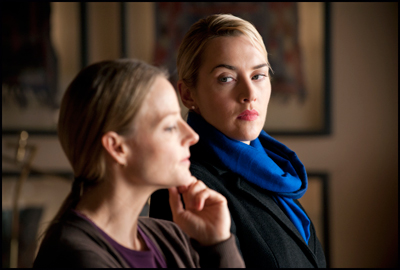 "I always love rehearsal," enthuses Kate Winslet. "It's always such a pleasure to be able to have it, such a luxury. But I don't think any of us could have predicted that Roman Polanski had us all learn the entire script, from start to finish, like a play. I was really thrilled that we staged the whole thing because it meant that when we got onto the set we all knew exactly what our positions were. That's helpful to us and to Roman Polanski because he can structure how he's going to shoot it. That rehearsal time was a very bonding experience for all of us. It's just so fun to have to rise to that challenge and to be with these actors who are so accomplished and so brilliant, and to feel the desire to match each other's ability is really wonderful."
"I always love rehearsal," enthuses Kate Winslet. "It's always such a pleasure to be able to have it, such a luxury. But I don't think any of us could have predicted that Roman Polanski had us all learn the entire script, from start to finish, like a play. I was really thrilled that we staged the whole thing because it meant that when we got onto the set we all knew exactly what our positions were. That's helpful to us and to Roman Polanski because he can structure how he's going to shoot it. That rehearsal time was a very bonding experience for all of us. It's just so fun to have to rise to that challenge and to be with these actors who are so accomplished and so brilliant, and to feel the desire to match each other's ability is really wonderful." For Kate Winslet, the rehearsal period allowed her to get to grips with the scene that caused her most trepidation, when she embarks on a drunken rant just moments after projectile vomiting all over Penelope's precious coffee table art books. "We all knew it felt a bit like a speech," she explains. "The challenge was making it feel as though it comes out of absolutely nowhere. How we solved that was mostly to do with Roman Polanski's direction which was always so bang on. But having staged it in the rehearsal meant we could see what worked and what didn't work and that was a real luxury. I was very relieved when it was done because it was a difficult scene. There's nothing worse than bad drunk acting!"
"The rehearsal gave me a chance to let the ideas settle to find a way for my character to speak the dialogue," says John C. Reilly. "It also allowed us all to find the rhythms and the way we should interact within the confined space of the set. And there was a great exchange of ideas, particularly about the dialogue. Roman Polanski was translating from the French original so he would say how a line would be said in French and we would make suggestions on how to make it sound authentically American. And the fact that there were no egos meant that we could have that frankness of communication."
"It's very helpful to be directed by a director who has acted before," continues John C. Reilly, "because not only are they more sympathetic towards actors but they have a good sense of the truth of the moments. Roman Polanski has a great innate sense of what it's like to have to act something. So he was as much interested in the rehearsal process, in the organic reality of the reactions and the behavior as we were. In rehearsal he would always question why we were doing something one way or another."
"I think it's been fun for Roman Polanski," says Jodie Foster about the rehearsal process. "Most of the direction was in rehearsals and so when the shoot began, most of his concerns were about how the camera would move, what the camera angles were and occasionally very subtle tweaks for us. Roman Polanski is a master technician and he's a master filmmaker and he has a very specific style and he's very consistent in the way he works: he puts the marks down and he sets the camera and he's there with his little viewfinder, which I haven't seen anyone use in about 20 years, and his is all scratched, it's from when he made Knife in the Water. He has an idea of the look that he wants for the movie but that is also a part of his lexicon too."
Christoph Waltz concurs: "The rehearsal was almost indispensable with this project. It wasn't just so we could get used to each other. It gave us the time to experiment, to try this and that, to reject things that weren't appropriate. On a regular shoot you never have the luxury of time."
"Shooting the film in real time is the great challenge," says Jodie Foster. "Whatever transitions are being made they're not being made off camera, they have to be made right then and there, and I think that the play is so beautifully drawn that it's kind of been easy to go from one feeling to the next. I've made a lot of movies in one location like this. What always happens when you do a film where there are only four people is that a closeness develops between the actors that you just can't get any other way. This has been the most enjoyable camaraderie that I've ever had on a movie. I genuinely love these actors and I was actually sad about not seeing them every single day."
The Look
A director known for his visual panache, Roman Polanski assembled a team of highly-creative behind the scenes collaborators including cinematographer Pawel Edelman, and Academy Award®-winning production designer Dean Tavoularis and costume designer Milena Canonero.
The brief for his production and costume designers was straightforward. "I wanted realism for the set design and costumes and a contemporary look," says Roman Polanski. "Those were the two notes I gave Milena and Dean, they don't need much advice!"
Almost as important as the four characters was the set. Constructed on the sound stages of Bry-sur-Marne on the outskirts of Paris, the set was created by production designer Dean Tavoularis, best known for his collaborations with Francis Ford Coppola on some of the most visually impressive films of the past 40 years including The Godfather trilogy, The Conversation and Apocalypse Now.
Dean Tavoularis designed a floor plan for a set which would be as authentic as possible, where it was possible to walk from one room to another, or to look from one room down the corridor to another, just as one would do in a real apartment. He also designed the apartment so that it would bring an extra dimension to the narrative at key moments. So the bathroom is accessed only by the bedroom which brings a heightened frisson to the scene where Penelope is helping Alan change out of his wet trousers in the bathroom - they have to pass the bed on their way back to the living room.
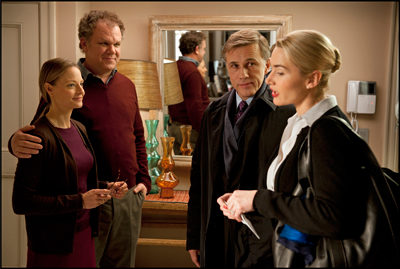 Dean Tavoularis, who worked with Roman Polanski on The Ninth Gate, had never designed a film of this type, set in one room and with just four characters. "I tried to make it as real as possible. I'm always very concerned about the details of a set because you never know exactly how much the director is going to show, if you're going to see inside the cupboard or inside the drawer. We had food and other items brought in from New York - and specifically Brooklyn - so that the apartment would be as authentic as possible. I was sure that some things wouldn't be seen on camera, but I still dressed it properly for the actors. That's especially important if you're going to be on the one set for the whole film."
Dean Tavoularis, who worked with Roman Polanski on The Ninth Gate, had never designed a film of this type, set in one room and with just four characters. "I tried to make it as real as possible. I'm always very concerned about the details of a set because you never know exactly how much the director is going to show, if you're going to see inside the cupboard or inside the drawer. We had food and other items brought in from New York - and specifically Brooklyn - so that the apartment would be as authentic as possible. I was sure that some things wouldn't be seen on camera, but I still dressed it properly for the actors. That's especially important if you're going to be on the one set for the whole film." His efforts certainly paid off. Says John C. Reilly: "When I saw the set, I thought that so much of my work had been done for me. Usually on films, the camera sees what the audience is meant to see so there's only half a set or if you open a book there's nothing inside the book�there's a lot of artifice. But Dean Tavoularis's set was filled with detail. It was completely realistic down to the strange little knickknacks on the shelves. The kitchen was almost functional. It definitely gave us a sense of place."
One of the pleasures for the designer, who had almost retired from the film industry and was enjoying a life as a painter until he got the call from Roman Polanski, was working in France. "I hadn't done a film for a few years and I was astonished by how extraordinary the French craftsmen were. The carpenters, the painters, the prop makers were all of an exceptional caliber."
Teaming up with Roman Polanski again brought home to the designer just how broad the director's talents are. It was often Roman Polanski who would see a way out of a problem, says Dean Tavoularis. "His knowledge encompasses every aspect of filmmaking, from the design to the visual effects. He would know exactly how to explain how to put something right. He gets to the reality and to the core. He's one of the greatest working directors in the world."
MORE
- Mission: Impossible Fallout
- Glenn Close The Wife
- Allison Chhorn Stanley's Mouth Interview
- Benicio Del Toro Sicario: Day of the Soldado
- Dame Judi Dench Tea With The Dames
- Sandra Bullock Ocean's 8
- Chris Pratt Jurassic World: Fallen Kingdom
- Claudia Sangiorgi Dalimore and Michelle Grace...
- Rachel McAdams Disobedience Interview
- Sebastián Lelio and Alessandro Nivola...
- Perri Cummings Trench Interview



